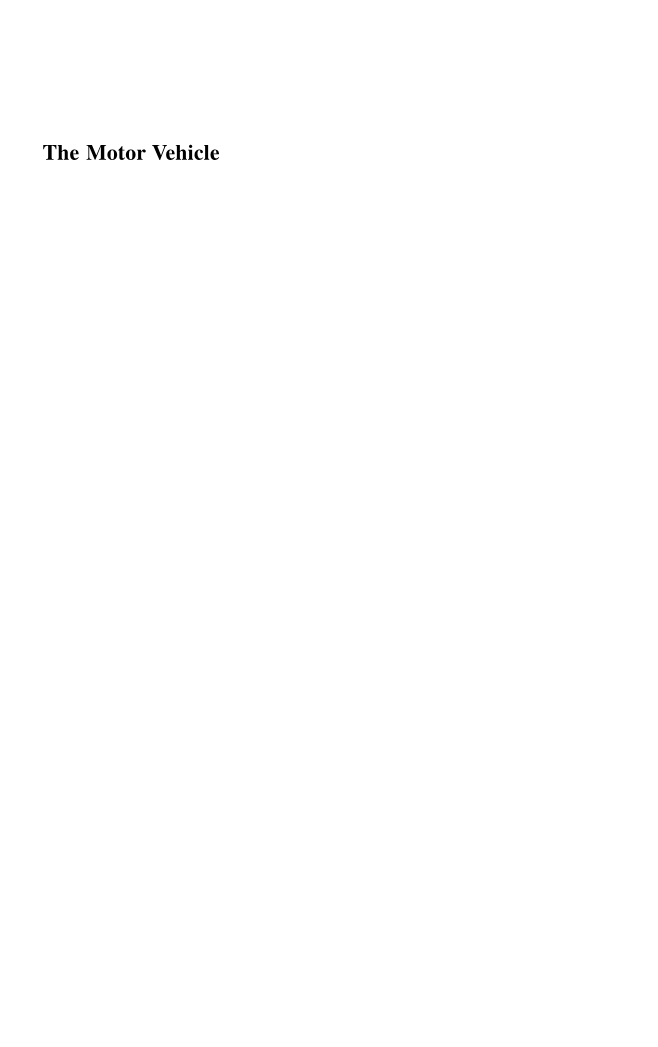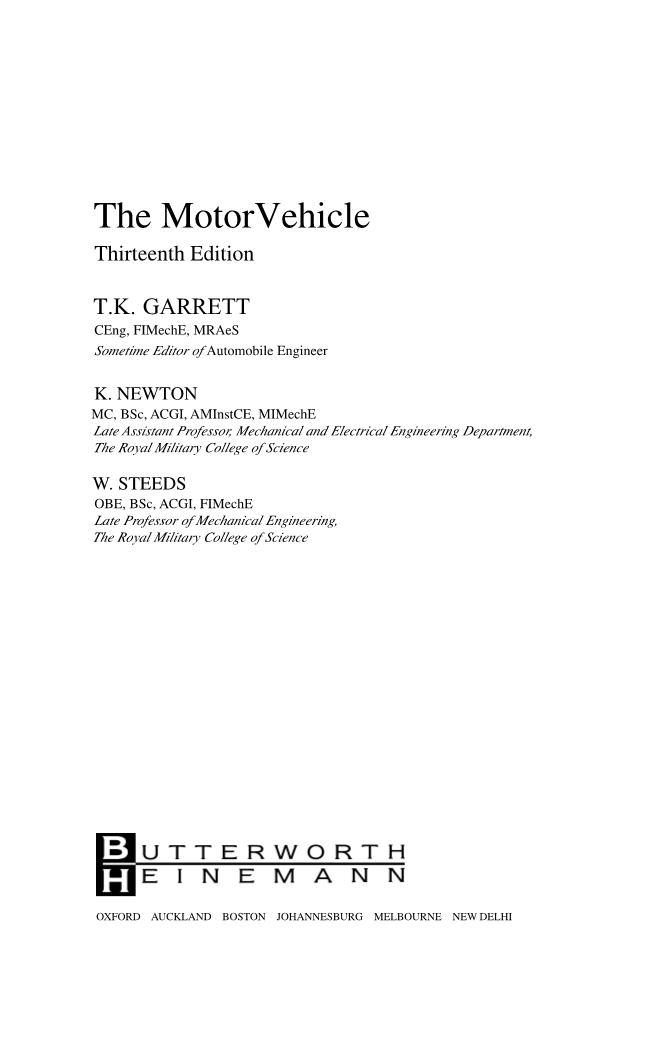前轴和转向机构外文翻译资料
2022-08-13 15:49:21


英语原文共 1188 页,剩余内容已隐藏,支付完成后下载完整资料
Front axle and steering mechanism
前轴和转向机构
Generally, the function of the steering system is thought of simply as that of providing a means whereby the driver can place his vehicle as accurately as practicable where he wants it to be on the road, for selection of the course he wants to steer round corners, and so that he can avoid other road users and obstructions. It must also, however, keep the vehicle stably on course regardless of irregularities in the surface over which the vehicle is travelling.
通常,转向系统的功能被简单地认为是提供一种装置,通过该装置驾驶员可以使其汽车尽可能准确地进行转向,以选择他想要行驶的道路,这样他就可以避开其他车辆和障碍物。同时,无论行驶的路面是否平整,它也必须使车辆稳定地行驶。
For the achievement of these basic aims, the first requirement is that, when the vehicle is travelling very slowly, all the wheels shall roll truly, that is, without any lateral slip. In Fig. 40.1, motion of the wheel along YY is pure rolling, along XX it is wholly slip. Motion along any other axis, ZZ for example, will have both rolling and slip components.
为了实现这些基本目的,第一个要求就是,当汽车行驶非常缓慢时,所有车轮都应该作纯滚动,即没有任何侧滑。在图40.1中,车轮沿YY的运动是纯滚动,沿XX的运动是完全打滑。沿着任何其他轴(例如ZZ)的运动将同时具有滚动和滑动分量。
Since for all the wheels on a vehicle to roll truly they must all move in the same direction perpendicular to their axes XX, these axes must all intersect at a common point. If the vehicle is on a straight course, this point will be at infinity, in other words the axes will be parallel. On the other hand, if the vehicle is turning a corner, this point will always be the centre about which the vehicle as a whole is turning, and the tighter the turn the closer it will be to the vehicle.
如果要使汽车上的所有车轮都作纯滚动,它们都必须沿垂直于其轴线XX的相同方向移动,所以这些轴线必须全部在相交于同一点。如果汽车在平直的道路上,则该点将在无穷远处,换言之,各个轴都将平行。另一方面,如果车辆在转向时,则该点将始终是整个汽车的转向中心,并且转弯幅度越大,它就越靠近汽车。
Unless both the front and rear wheels are to be steered – impracticable on grounds of complexity, except in special circumstances, such as on vehicles having more than eight wheels, in which it may be virtually inescapable – the common centre must lie somewhere along the lines of the axis produced of the fixed rear axle. As can be seen from Fig. 40.2, this means that, when the front wheels are steered, their axes must be turned through different angles so that the point O of their intersection is always on that axis produced. With a beam axle this can be done by pivoting the whole axle assembly about a vertical axis midway between its ends. However, such an arrangement is impracticable for any but very slow vehicles.
除非前后轮都不能操纵,否则共同的中心必须位于沿线的某个位置固定后轴产生的轴的角度——出于复杂性的考虑,这是不可行的,除非在特殊情况下,例如在具有八个以上车轮的汽车上,这实际上是不可避免的。从图40.2可以看出,这意味着,在前轮转向时,其轴必须旋转不同的角度,以使它们的交点O始终位于所产生的轴上。对于横梁轴,可以通过使整个轴组件绕其两端之间的垂直轴转动来完成。然而,对于行驶非常缓慢的汽车而言,这种布置是不可行的。
Generally, the wheels are carried on stub axles, A and B in Fig. 40.2. Except with independent suspension, these stub axles are pivoted on the ends of the axle beam C which, since it is connected by the road springs to the chassis frame, remains in effect parallel to the rear axle, as viewed in plan. With independent suspension, the principle remains the same, even though the mechanism is different in detail. The arms D and E together with their associated stub axles form what amounts to bell-crank levers pivoted on the kingpins and are used for coupling the two wheels so that they move together when they are steered. These arms are termed the track arms and are interconnected by the track rod. The actual steering is usually effected by a connecting link, called a drag link, between the steering gear and either what is termed the steering arm on the adjacent stub axle assembly or, in some instances, part of the track rod system.
通常,车轮安装在短轴上(图40.2中的A和B)。这些短轴除了具有独立的悬架之外,还以车轴梁C的端部为中心转动,由于通过板簧将其连接至底盘车架,因此在平面图中实际上平行于后轴。对于独立悬架,即使其结构有所不同,原理仍保持不变。轴D和E及其相关的短轴构成了绕主销旋转的曲柄杆,用于联接两个车轮,以便在转向过程中一起转动,这些轴被称为履带轴,并通过履带轴相互连接。实际上,转向通常由转向齿轮与相邻的短轴组件上的所谓转向轴之间的连接链(称为拖链),或在某些情况下,由履带轴系统的一部分进行。
40.1 Ackerman linkage
Ackerman连杆机构
From the illustration it can be seen that there is a difference between the angles alpha; and beta; through which the wheels on the inside and outside respectively of the curve have to be turned. In practice, this difference is obtained by setting the arms D and E at angles such that, in the straight-ahead position, shown dotted, lines drawn through the centres of the two pivots on each intersect near the centre of the rear axle. The exact position of this intersection point depends on the relationship between the wheelbase and track, and other factors.
从该图中可以看出,角度alpha;和beta;之间存在差异,必须分别使弯道内侧和外侧的车轮转动该角度。实际上,这种差异是通过将臂D和E设置成一定角度而获得的,使得如虚线所示的直线,穿过两个枢轴中心的线在每个后轴中心附近相交。 该相交点的确切位置取决于轴距和轨道之间的关系以及其他因素。
From Fig. 40.3 can be seen how the stub axles are steered differentially by this linkage, the full lines depicting the straight-ahead and the dotted lines a steered condition. In the latter, the stub axle B has turned through an angle beta; and the end D of its track arm has moved to D′, a distance x parallel to the axle beam. Neglecting the slight angle of inclination of the track rod, it follows that the end C of the other track arm must move the same distance x parallel to the axle beam. This, however, entails movement of the arm C through a greater angle than D, because the latter is swinging across bottom dead centre, as viewed in plan, while the former is moving further from its corresponding lowest point. Although, for practical reasons, these arms may have to be curved, perhaps to clear some other part of the wheel or brake assembly, the effective arm remains that of a straight line joining the centres of the kingpin and the pivot at the opposite end.
从图40.3可以看出,该连杆机构如何使短轴进行转向,其中实线表示直线行驶,而虚线表示转向行驶。在后者中,短轴B已转过角度beta;,其轴的末端D已移至D,即平行于车轴的距离x。忽略履带轴的微小倾斜角度,可以得出结论,另一个履带轴的末端C必须平行于车轴并移动相同的距离x。但是,这需要使轴C的转过的角度大于D的角度,因为从平面图来看,后者在下止点处摆动,而前者则从其相应的最低点开始移动。尽管出于实际原因,这些轴可能会弯曲,也许是为了消除车轮或制动器组件的其他部分的影响,但有效轴仍然是一条直线,该直线将主销和轴的中心连接到相反的一端。
The illustrations show the t
剩余内容已隐藏,支付完成后下载完整资料
资料编号:[235999],资料为PDF文档或Word文档,PDF文档可免费转换为Word




